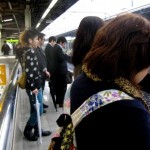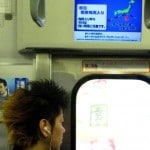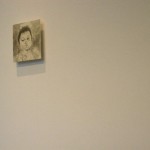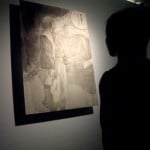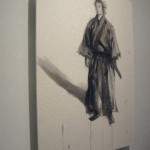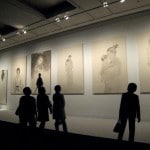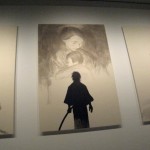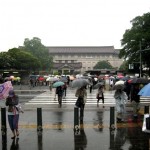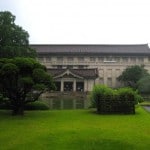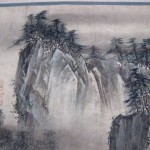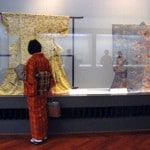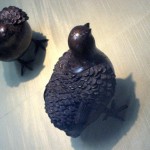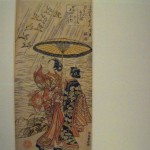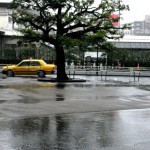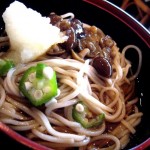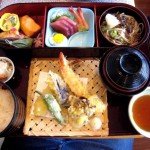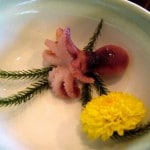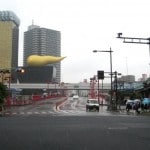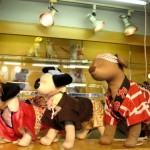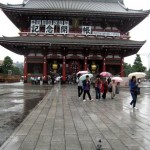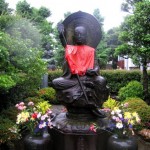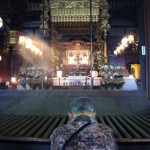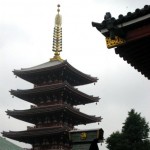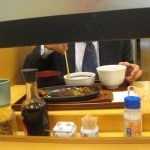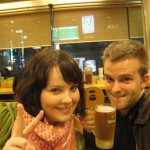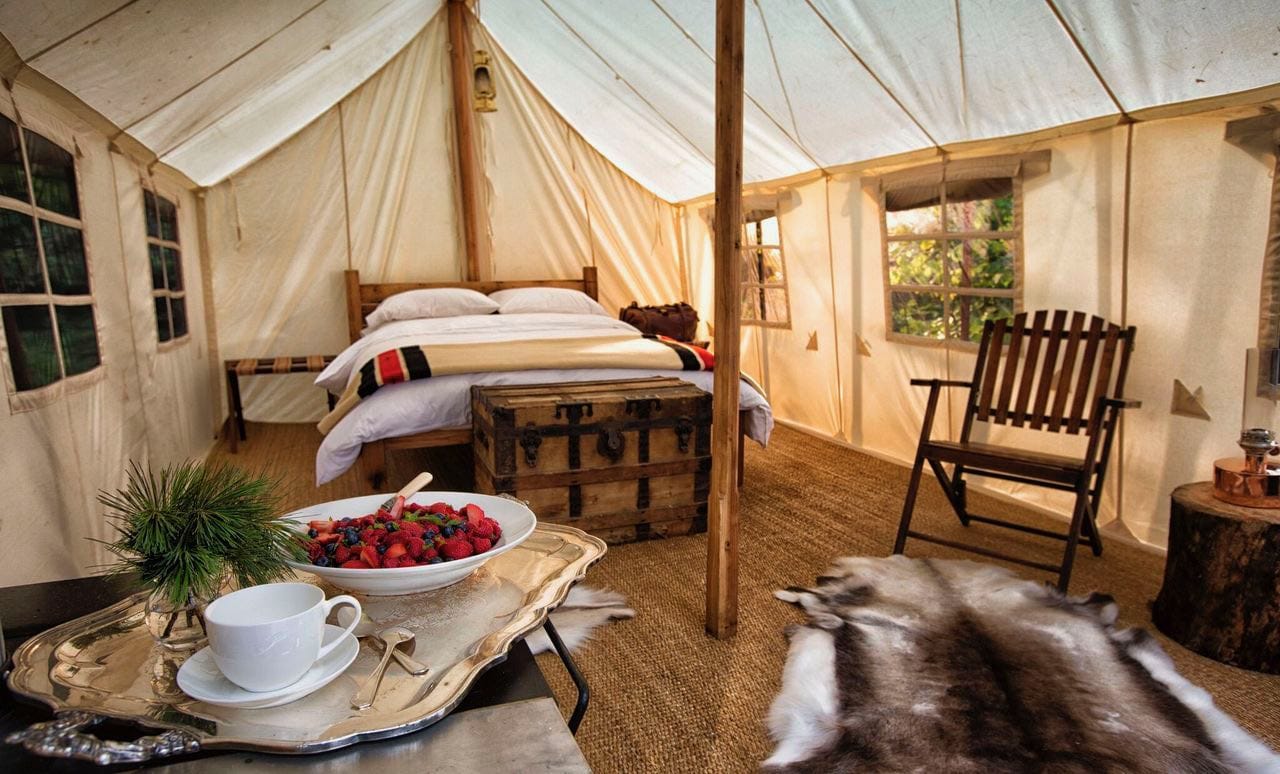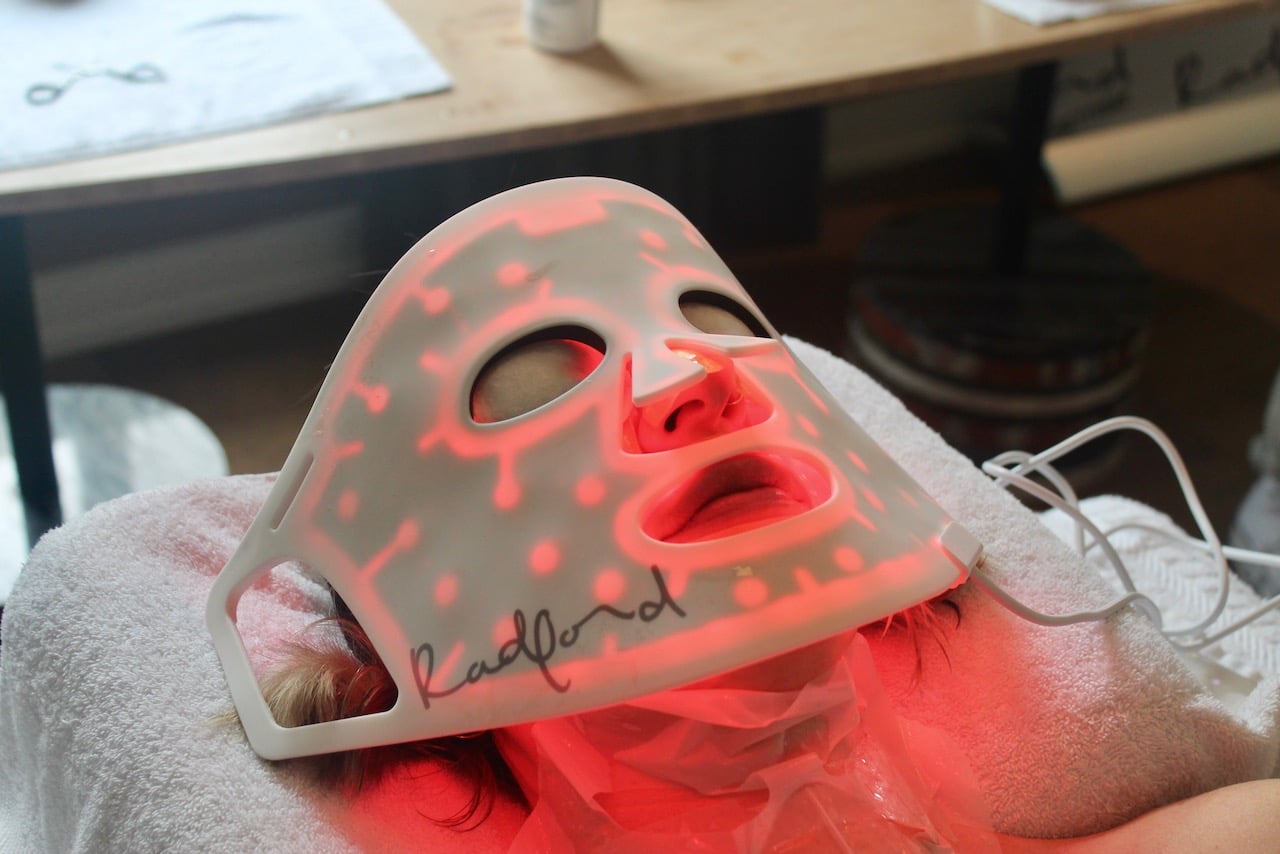I woke up on Tuesday with the sound of rain showers rat-a-tat-tatting on the window beside my bed. I threw on my jacket and prepared myself for a final day of wet site seeing in the capital. I walked to Ikebekuro station with my black umbrella clutched over around my neck as the rain pitter pattered through the streets. I hopped on the metro and arrived at Ueno Station to find a rather vigorous downpour. I skipped up the street and couldn’t help but laugh as I stared over the park to find a long line of what seemed like thousands of bobbing umbrellas as far as the eye could see.
I walked up a long staircase and arrived at the southern end of Ueno Park. Luckily happenstance was on my side and I walked right into the Ueno Royal Museum which had a massive billboard up which read: Inoue Takehiko: The Last Manga Exhibit. The ticket line up was huge so I walked up to a few university students who told me that they had been waiting for months to see this exhibit. And just like that, snap, I was sold.
Takehiko Inoue is a Japanese manga artist, best know for his Japanese manga Slam Dunk, which has become a success both in Japan and overseas (he draws most of the anime ads for Nike Asia). It received the Shogakukan Manga Award and was declared Japan’s favorite manga. It has sold over 100 million copies in Japan alone. He’s famous for doing pages and pages of manga where there are no words at all. Just facial expressions and action shots frozen as though captured by a professional sports photographer.
The artist’s latest challenge takes place in this museum space. Over 100 new and original drawings construct this temporary manga space. This new series, is about the famous 17th century swordsman Miyamoto Musashi. To add a historical touch to his work, he used sumi ink and a calligraphy brush. True to his last-minute style, he was working on the giant centerpiece (a 3-meter-tall portrait of Miyamoto) until 3am the day the exhibit opened.
The exhibit was packed full of people of all ages. The exhibition was huge and I found it interesting to watch the locals interacting with the art which has made their country so famous. The room was full of giggles, looks of awe and quick banter. The artist is brilliant. It is amazing how cartoonists (especially manga artists) are able to capture speed on a two dimensional piece of paper. His works ranged in size from small page sized sketches to massive canvases which were several meters high and designed to shock and awe. The samurai theme was rather delightful and I appreciated the insane number of artistic details that went into each calligraphy sketch. One of the rooms featured a floor covered in sand. Participants are supposed to feel as though they are walking on a beach. The paintings in this room featured huge white canvases with a small two inch ink sketch of a samurai standing overlooking an ocean shore as blurred birds flow above his head. I felt ever so fortunate to have been able to experience this unique side of Japan’s art scene and have a new found appreciation and respect for the countries ever so talented cartoonists.
I grabbed my umbrella and weathered the storm as I walked towards the Ueno pond. In the summer the pond is a popular hang out for families as there are several swan shaped paddle boats for rent to putter about on. Adjacent to the pond is the Ueno Zoo and directly in the middle of the two is a charming stone bridge which leads up to the Parks Buddhist shrine. The smell of incense wafted through the damp air as I stopped to take a few pictures of the outdoor Buddha statues. I was mesmerized by the shallow end of the pond where a sort of cove protects an amalgamation of monster lily pads. These bright green pads stood above the water a few inches and were the size of tire trucks. I couldn’t help but think that Monet would have gone a bit crazy at the sight of these bizarre plants.
I walked to the very end of the pond and realized that I had reached the far exit of the Park. I was so peeved at myself. I had come to the Park to see the Tokyo National Museum which is located on the other side of the Park. Soaking in the rain I begrudgingly walked out of the Park and tried to use my ill sense of direction to direct myself around the Park to the main entrance. I ended up getting lost about five times in a residential community rife with tiny one way streets. I was fortunate enough to experience an authentic little burrow of Tokyo with traditional old Japanese architecture dotted in between some very posh apartment buildings. Always looking on the bright side of things, I always figure if I am on vacation there is no such thing as getting lost. Since I have never been “here before.” Where ever I am, there is something new to discover.
I ran into a beautiful University student who could tell I was ridiculously lost and offered to take me to the museum as he was headed in that direction. He told me that he was an art student at the Ueno Art School where he studies jewelry (he specializes in silver and excitedly showed me his fingers where his various creations sat around his knuckles).
I bid my new friend farewell as he ran to his class and I walked to the entrance of the Tokyo National Museum. It is the oldest and largest museum in Japan. The museum houses and preserves art and archaeological objects from all of East Asia with a focus on Japan. There are five different buildings on the Museum property which house various collections. I headed straight for the Honkan Japanese Gallery which holds the countries most prized treasures of the past. This particular gallery consists of chronological exhibits starting in 10,000 BCE to the late 19th century. These exhibits are organized by type, such as paintings, sculptures, ceramics, swords and kimono. The building was designed by Watanabe Jin and was inaugurated in 1938 as a representative building of Imperial (teikan) style.
I spent the next hour strolling through the spacious rooms of this palace of art history. I particularly enjoyed one room which featured massive golden and stone Buddha’s. The gallery also houses an amazing collection of samurai paraphernalia such as swards and battle gear. Several colourful kimono’s stood in glass closures in one room which opened into a large gallery of traditional Japanese Geisha centered paintings. A vast collection of the nations beautiful ceramics, calligraphy and rural scenes splattered onto murals were also a highlight.
Already unavoidably damp I walked back out into the rain for a ten minute walk through a rose garden to the Metro. I couldn’t help but appreciate how many different colourful umbrella’s there are in Japan. The entire city was covered in a multi coloured assortment of fabric domes which hovered in the air. I was starving for a good hot meal and was hoping to dry up a bit before continuing on with my day.
I found a sit down noodle restaurant located directly adjacent from the station so ran up the stairs and was seated at my own table within a buzzing and busy dinning room. I sipped on a cup of Green Tea and cleaned my hands in lemon water while waiting for my lunch. I had decided to splurge on my meal as this particular restaurant had a large platter containing what seemed like hundreds of Japanese treats. I sat for twenty minutes as each little dish of my meal was carefully and creatively constructed in the kitchen. I flipped through the damp pages of my book, Holy Cow, and found it rather funny that the author was rambling on about her encounter with Buddhist philosophy in India as I just spent the last hour walking through ancient Japanese Buddhist relics.
A tray packed with little compartmentalized foody art pieces sat in front of me. Before eating anything I spent about ten minutes taking as many pictures of each perfectly prepared treat. I had also ordered a bowl of thinly sliced leeks deep fried in a spicy tempura batter. My waitress squeezed a lemon wedge over these crispy strips before I devoured the entire bowl.
Staring down at my tray I tasted each little dish and here is what I discovered:
A bowl of perfectly steamed sticky rice.
A small bowl of fried urchin, pickled pink cabbage and julienned carrot in sweet mayo.
A whicker basket of tempura shrimp, oyster mushroom, hot green pepper and squash.
A cold roast salmon steak, mini purple octopus the size of my thumb and a green spruce branch for a bit of colour on the plate.
Cold udon noodle, yellow edible flower, slices of bright pink tuna sashimi and tiny raw shrimp the texture of jello.
A bowl of soba noodles, tiny mushroom buds, raw shaved sweet potato in miso broth.
Fried scallop, caviar, and two slices of smoked ham and sesame omelet.
Amazing how a meal can be such an adventure in new tastes, aromas and textures. I hopped out of my seat feeling perfectly gastronomically content. On the subway I headed to the Old Tokyo district of Asakusa.
After walking out of the main subway exit you immediately get a sense that this is a touristy area. On the street Japanese men dressed in black and wearing whicker triangular hats motioned for tourists to hop onto their rickshaws. For most of the 20th century Asakusa was the major entertainment district of Tokyo. It is a now a hub for traditional ryokan inns, restaurants and a colourful assortment of shrines and temples. Asakusa is also famous for several shops which sell top of the line chef knives and kitchen necessities.
Senso-ji, also known as Asakusa Kannon, is Tokyo’s largest Buddhist temple. I first walked under the Kaminarimon (Thunder Gate), featuring a much photographed giant lantern and statues of guardian gods Raijin (god of thunder) and Fujin (god of wind). First built in 942, the gate has been destroyed numerous times and the current incarnation dates to only 1950. The Nakamise tourist shopping arcade leading up to the temple starts just after this gate. At the end of the arcade is the main gate Hozomon, notable for a giant straw sandal hung up on one side. This gate too is guarded by ferocious guardian gods. The perennially busy Kannondo, is behind the gate, with a steady stream of worshippers wafting incense over themselves and trooping up the steps to pray. According to legend, the hall was originally built in 628 to house a statue of Kannon, the Godess of Mercy, fished out of the Sumida River by two brothers. To the west is the Gojunoto, a five story pagoda, reputedly containing some of the ashes of Buddha.
I spent a few minutes inside the temple with the sweet smell of incense drifting through the pouring rain. I walked around the temple and found a small little garden with a few massive Buddha’s sitting contently. I heard a scream and walked around a tree to find two preschooler boys dressed in their school uniforms standing ankle deep in rain water. It had rained so much today that a pond had formed in front of one of the shrines and these boys were soaking wet. One of the boys grabbed a massive monster truck toy and tip toed back onto the pavement.
I returned to my little home in Ikebukuro and relaxed for the next few hours before packing and heading out with Kat for my night bus to Kyoto. We stopped for dinner together at a fabulous little spot on the main street in Ikebukuro. Japan is famous for their wild ideas but Tokyo’s Vending Machine Restaurants may just take the cake.
The front of the restaurant displays plastic art pieces for the various items on their menu. Once in the restaurant there are two vending machines on either side of the door. Each menu item has its own button. We pushed a button for our desired meal and also selected a draft beer for two dollars with the simple push of a button. We slid our money into the vending machine and our food ticket was printed as our change clattered into the bowl bellow.
We sat down and I was beyond elated at this very bizarre restaurant concept. An energetic little waitress rushed over to our seat, grabbed our tickets and plopped a pint of Kirin Draft on my table. Moments later a tray of Tonkatus (Japanese breaded pork cutlet) arrived. The piping hot cutlet was accompanied by a fresh salad with sesame dressing, miso broth, sticky rice and a perfect white cube of tofu sprinkled with rings of green scallions. This restaurant concept is Tokyo’s take on a more dignified and refined form of solo fast food eating. The dinning room contains zero booths. Just a ring of stools where friends eat together or businessmen quickly grab a bite to eat. I found it rather charming that the music playing through the dinning room was a very calming classical jazz tune. The concept works perfectly. The restaurant saves money on labour as each patron chooses their own menu items and seat themselves. The food was great quality and only cost me nine dollars for the whole kit and caboodle.
Kat and I headed to Shinjuku Station (which I had been avoiding the past few days). Shinjuku is a major commercial and administrative center of the city, housing the busiest train station in the world, and the Tokyo Metropolitan Government Building, along with several other notable skyscrapers. As of 2008, the ward has an estimated population of 312,418 and a density of 17,140 persons per square kilometer. Mind blowing Shinjuku Station, the busiest train station in the world (in terms of number of passengers) is used by an average of 3.6 million people per day. The station has an underground arcade with a total of over 200 exits!
After hopping off the subway Kat and I just sort of let our jaws drop as the world passed by us at lightening speed. This would be the perfect place to sit and people watch. On the other hand, it is the worst place to be when you are in a rush or horribly lost. We wondered around the station for a few minutes before finding the proper exit to the main street. The city was covered in thick fog. Staring directly up in the sky I could see the tips of several gigantic sky scrapers which glowed dimly through the clouds.
We found my bus stop and I gave Kat a hug a goodbye so she could get home before the metro closed for yet another day. For the next thirty minutes I watched a wild mix of Japanese youth boarding their various buses. When my bus finally arrived I hopped up the stairs and found my seat at the very front behind the driver. At midnight we were jetting across the city. I popped a sleeping pill into my mouth and spent the next several minutes staring out the window as a maze of highways, bridges and skyscrapers flashed by.




